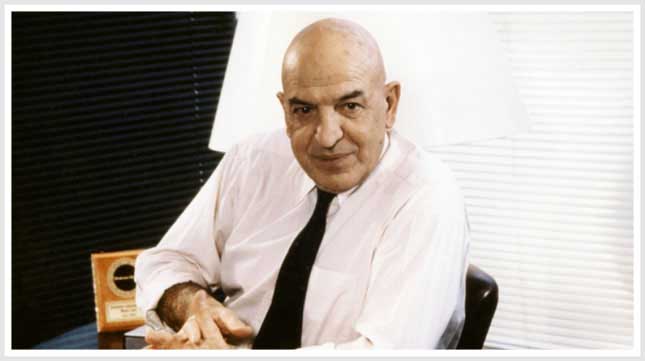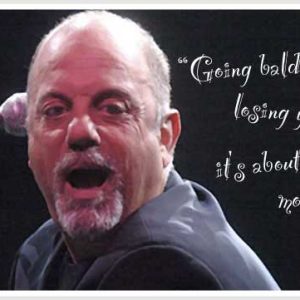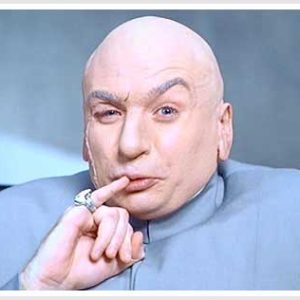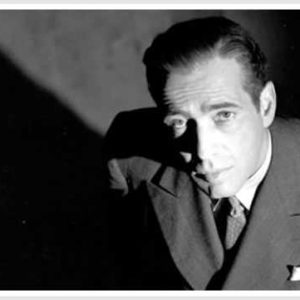
FROM TELLY SAVALAS TO DON RICKLES, TALENTED AND DIVERSE ACTORS WITH HAIR LOSS GAVE TV VIEWERS CHOICES IN THE 1970S.
“Who loves ya, baby?”
For anyone who grew up with network television in the 1970s, those four words bring back a flood of memories. They were uttered by Telly Savalas, playing the title role in the hit ABC-TV series Kojak, and they struck a resounding chord. And since Savalas was a bald actor playing a leading character — and one with demonstrated sex appeal — they also struck a resounding blow for bald men everywhere, proving (again) that sensuality comes in many guises.
There actually were a number of bald or balding actors in leading roles during the 1970s. When Kojak was added to the CBS Wednesday evening lineup in 1973, it joined another popular crime series with a balding leading man, Cannon. William Conrad, the star of the latter series, may not have become the sex symbol that Savalas did, but his impressive deep voice and expert sleuthing made him a compelling character, keeping the series in the top 30 of the Nielsen ratings for four of its five seasons.
On ABC, David Carradine may not have been bald, but the character he played on Kung Fu certainly was — part of the time. Carradine’s wandering Shaolin monk was coiffed in the “Old West” portions of the show; but in the frequent flashbacks to his days as a mere student (nicknamed “Grasshopper”), Carradine sported a bald look that suited him extremely well. Keye Luke, playing Grasshopper’s Master Po, was similarly decoiffed. Although Kung Fu ran a shorter time than either Kojak or Cannon, it arguably made a deeper impression on its target audience.
Edward Asner is another 1970s leading man who was fairly devoid of locks. Although his Lou Grant character may not have been the title role in the highly influential comedy The Mary Tyler Moore Show, it was far and away from the most important male role on the show and a crucial ingredient in its success. When Asner then moved on to his own Lou Grant series, he became the clear and undisputed star, managing the difficult trick of turning a comedic character into a believably dramatic one.
The bald king played better on the big screen than on TV in the 1970s
A perhaps less successful transition was undertaken by Yul Brynner, a bald movie icon who in 1972 took his big-screen musical character of the King of Siam (from The King and I) and brought him to the small screen in the short-lived comedy Anna and the King. Although Brynner still possessed a commanding presence, he seemed a bit uncomfortable when shrunken down to TV size; of course, the poor scripts he had to work with also may have contributed to that discomfort.
Gavin MacLeod had an easier time of it. His transition from supporting player on The Mary Tyler Moore Show to lead on The Love Boat didn’t involve playing the same character. The Love Boat’s Captain Merrill Stubing, however, allowed MacLeod to continue to exploit his warmth and comedic timing while also calling on him to demonstrate that he was strong enough to “anchor” a series — not an easy accomplishment given the fragmentary nature of The Love Boat’s episodes.
Over at Eight Is Enough, leading man Dick Van Patten faced a different problem: proving that he could anchor a series in which cute kids and terrific teens threatened to pull the spotlight away from him. Fortunately, Van Patten was more than capable, and the series made the experienced character actor a real star; his appealing and funny yet solid personality helped to keep the show on for five seasons.
Bald men were big on laughs on the TV of the 1970s
Eight Is Enough was an hour-long series, but it was essentially a comedy; it even had a laugh track. Men with hair loss also played leading roles in a number of half-hour situation comedies during the 1970s.
David Ogden Stiers (as Major Charles Winchester on M*A*S*H), Danny DeVito (as Louie on Taxi), Gordon Jump (Arthur Carlson on WKRP in Cincinnati) and Graham Jarvis (Charlie Haggers on Mary Hartman, Mary Hartman) may have been members of ensemble casts rather than leading players, but Sherman Hemsley was definitely the leading male actor on the long-running The Jeffersons. That show, of course, spun off from the hugely influential All in the Family, whose Carroll O’Connor and Rob Reiner had progressively higher foreheads and other hair loss as the show progressed.
Redd Foxx wore a hat often on Sanford and Son, but beneath the hat was noticeable hair loss, and the marvelously deadpan lead in The Bob Newhart Show showed signs of thinning and receding. On Chico and the Man, Freddie Prinze’s Chico had a head full of hair, but Jack Albertson’s Man had less so.
And there were any number of balding comics that starred in not-so-successful sitcoms during the period, including Don Rickles (The Don Rickles Show and CPO Sharkey), Herschel Bernardi (Arnie), James Coco (Calucci’s Department), Abe Vigoda (Fish), Dom DeLuise (Lotsa Luck), J. Pat O’Malley (A Touch of Grace), Pat Morita (Mr. T and Tina) and Tim Conway (The Tim Conway Show).
So, while many may think of the 1970s as an era of Afros, shag cuts and John Travolta pompadours, the men above prove that there were plenty of men making their mark in the entertainment world who found that where hair was concerned, less was more.
















